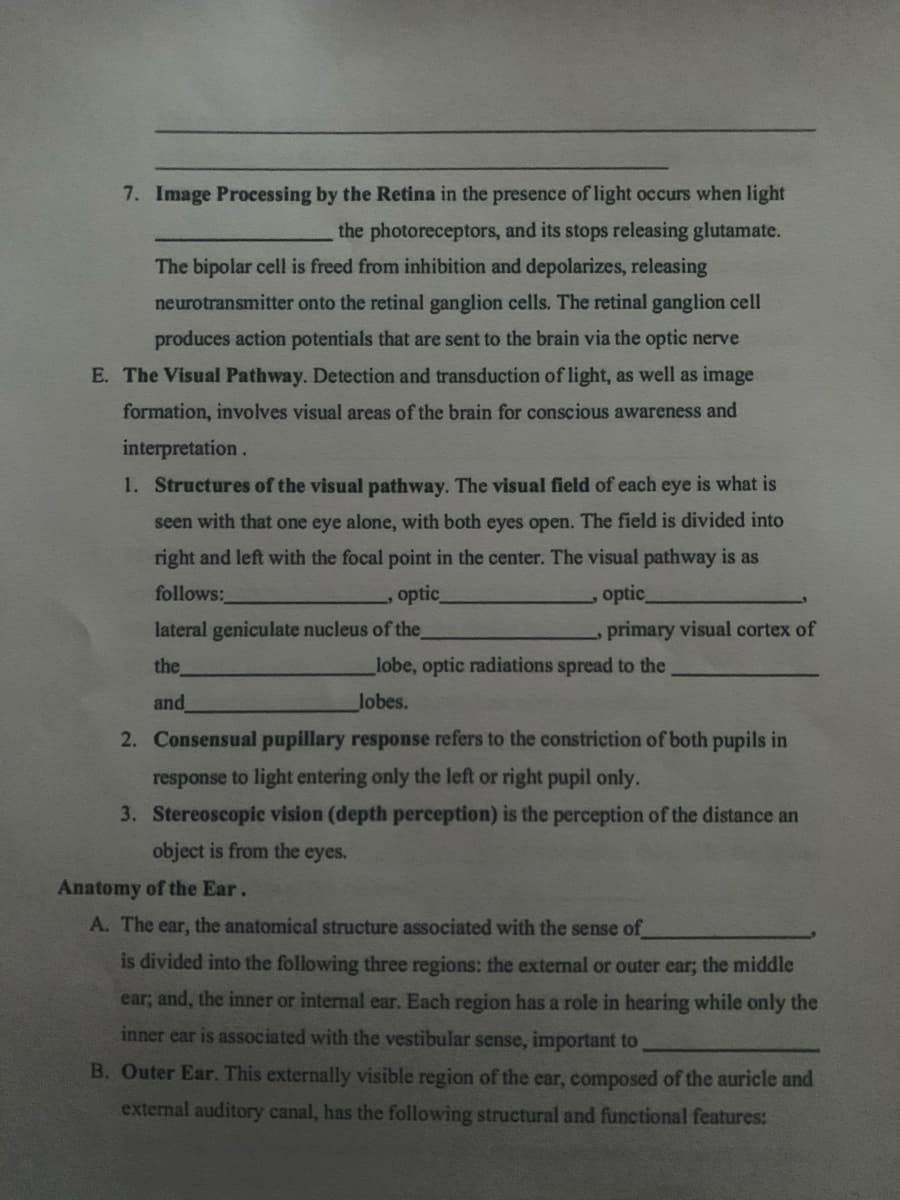7. Image Processing by the Retina in the presence of light occurs when light the photoreceptors, and its stops releasing glutamate. The bipolar cell is freed from inhibition and depolarizes, releasing neurotransmitter onto the retinal ganglion cells. The retinal ganglion cell produces action potentials that are sent to the brain via the optic nerve
7. Image Processing by the Retina in the presence of light occurs when light the photoreceptors, and its stops releasing glutamate. The bipolar cell is freed from inhibition and depolarizes, releasing neurotransmitter onto the retinal ganglion cells. The retinal ganglion cell produces action potentials that are sent to the brain via the optic nerve
Human Physiology: From Cells to Systems (MindTap Course List)
9th Edition
ISBN:9781285866932
Author:Lauralee Sherwood
Publisher:Lauralee Sherwood
Chapter6: The Peripheral Nervous System: Afferent Division; Special Senses
Section: Chapter Questions
Problem 2SQE
Related questions
Question
Fill in blankk

Transcribed Image Text:7. Image Processing by the Retina in the presence of light occurs when light
the photoreceptors, and its stops releasing glutamate.
The bipolar cell is freed from inhibition and depolarizes, releasing
neurotransmitter onto the retinal ganglion cells. The retinal ganglion cell
produces action potentials that are sent to the brain via the optic nerve
E. The Visual Pathway. Detection and transduction of light, as well as image
formation, involves visual areas of the brain for conscious awareness and
interpretation.
1. Structures of the visual pathway. The visual field of each eye is what is
seen with that one eye alone, with both eyes open. The field is divided into
right and left with the focal point in the center. The visual pathway is as
follows:
optic
optic
lateral geniculate nucleus of the_
primary visual cortex of
the
lobe, optic radiations spread to the
and
lobes.
2. Consensual pupillary response refers to the constriction of both pupils in
response to light entering only the left or right pupil only.
3. Stereoscopic vision (depth pereception) is the perception of the distance an
object is from the eyes.
Anatomy of the Ear.
A. The ear, the anatomical structure associated with the sense of
is divided into the following three regions: the external or outer ear; the middle
ear; and, the inner or internal ear. Each region has a role in hearing while only the
inner ear is associated with the vestibular sense, important to
B. Outer Ear. This externally visible region of the ear, composed of the auricle and
external auditory canal, has the following structural and functional features:
Expert Solution
This question has been solved!
Explore an expertly crafted, step-by-step solution for a thorough understanding of key concepts.
This is a popular solution!
Trending now
This is a popular solution!
Step by step
Solved in 2 steps

Knowledge Booster
Learn more about
Need a deep-dive on the concept behind this application? Look no further. Learn more about this topic, biology and related others by exploring similar questions and additional content below.Recommended textbooks for you

Human Physiology: From Cells to Systems (MindTap …
Biology
ISBN:
9781285866932
Author:
Lauralee Sherwood
Publisher:
Cengage Learning

Anatomy & Physiology
Biology
ISBN:
9781938168130
Author:
Kelly A. Young, James A. Wise, Peter DeSaix, Dean H. Kruse, Brandon Poe, Eddie Johnson, Jody E. Johnson, Oksana Korol, J. Gordon Betts, Mark Womble
Publisher:
OpenStax College

Biology: The Dynamic Science (MindTap Course List)
Biology
ISBN:
9781305389892
Author:
Peter J. Russell, Paul E. Hertz, Beverly McMillan
Publisher:
Cengage Learning

Human Physiology: From Cells to Systems (MindTap …
Biology
ISBN:
9781285866932
Author:
Lauralee Sherwood
Publisher:
Cengage Learning

Anatomy & Physiology
Biology
ISBN:
9781938168130
Author:
Kelly A. Young, James A. Wise, Peter DeSaix, Dean H. Kruse, Brandon Poe, Eddie Johnson, Jody E. Johnson, Oksana Korol, J. Gordon Betts, Mark Womble
Publisher:
OpenStax College

Biology: The Dynamic Science (MindTap Course List)
Biology
ISBN:
9781305389892
Author:
Peter J. Russell, Paul E. Hertz, Beverly McMillan
Publisher:
Cengage Learning


Biology 2e
Biology
ISBN:
9781947172517
Author:
Matthew Douglas, Jung Choi, Mary Ann Clark
Publisher:
OpenStax

Biology (MindTap Course List)
Biology
ISBN:
9781337392938
Author:
Eldra Solomon, Charles Martin, Diana W. Martin, Linda R. Berg
Publisher:
Cengage Learning